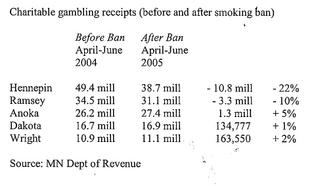As MN House members hear testimony next week....

I decided it was relevant to update this post, as well as email it to county commissioners, city council members, and MN lawmakers.
Note: These are the same figures Bloomington city councilmembers recently looked at and then concluded that the smoking ban would remain as is, prompting the 4th floor Mall of America shutdown and Southtown Bingo closures.....Is it any wonder with financial savvy like that why local governemnt cannot make ends meet without new tax increases every year?
Observation: Notice that the $10.8 million loss in Hennepin county and $3.3 million loss in Ramsey didn't translate to a $14.1 million gain in the surrounding counties.....that's because customers subjected to a smoking ban didn't just stop gaming purchases in their respective county and spend those discretionary dollars in neighboring smoker friendly counties....they stopped spending those discretionary dollars period. A statewide smoking ban will have similar 20% state gaming loss across the board.....that's what you call "leveling the playing field."
Hospitality businesses throughout the state employ more than 127,000 people and pay $3.3 billion in wages each year, making our industry Minnesota's second-largest employer. Annual sales for the industry exceed $8.3 billion and generate nearly $1 billion in tax receipts.
Don't buy into the non-profits' argument that a statewide smoking ban means businesses won't fail.....Hennepin County businesses can tell you how that worked out. Afterall the NY ban is statewide and so far 2,600+ jobs have been lost in hospitality, check out the number of NY bars that have gone out of business since their statewide smoking ban. Ireland's smoking ban is responsible so far for 7,600 lost jobs and 200+ pubs out of business.
Besides Minnesota local environmental health department air quality testing proved secondhand smoke levels are 150 times safer than OSHA requires. While the American Cancer Society's air quality testing proves secondhand smoke levels are 25,000 times safer than OSHA air quality regulations.



 "Though we may not be able to protect your business property rights, we certainly support your Second Amendment Rights"
"Though we may not be able to protect your business property rights, we certainly support your Second Amendment Rights" 

<< Home